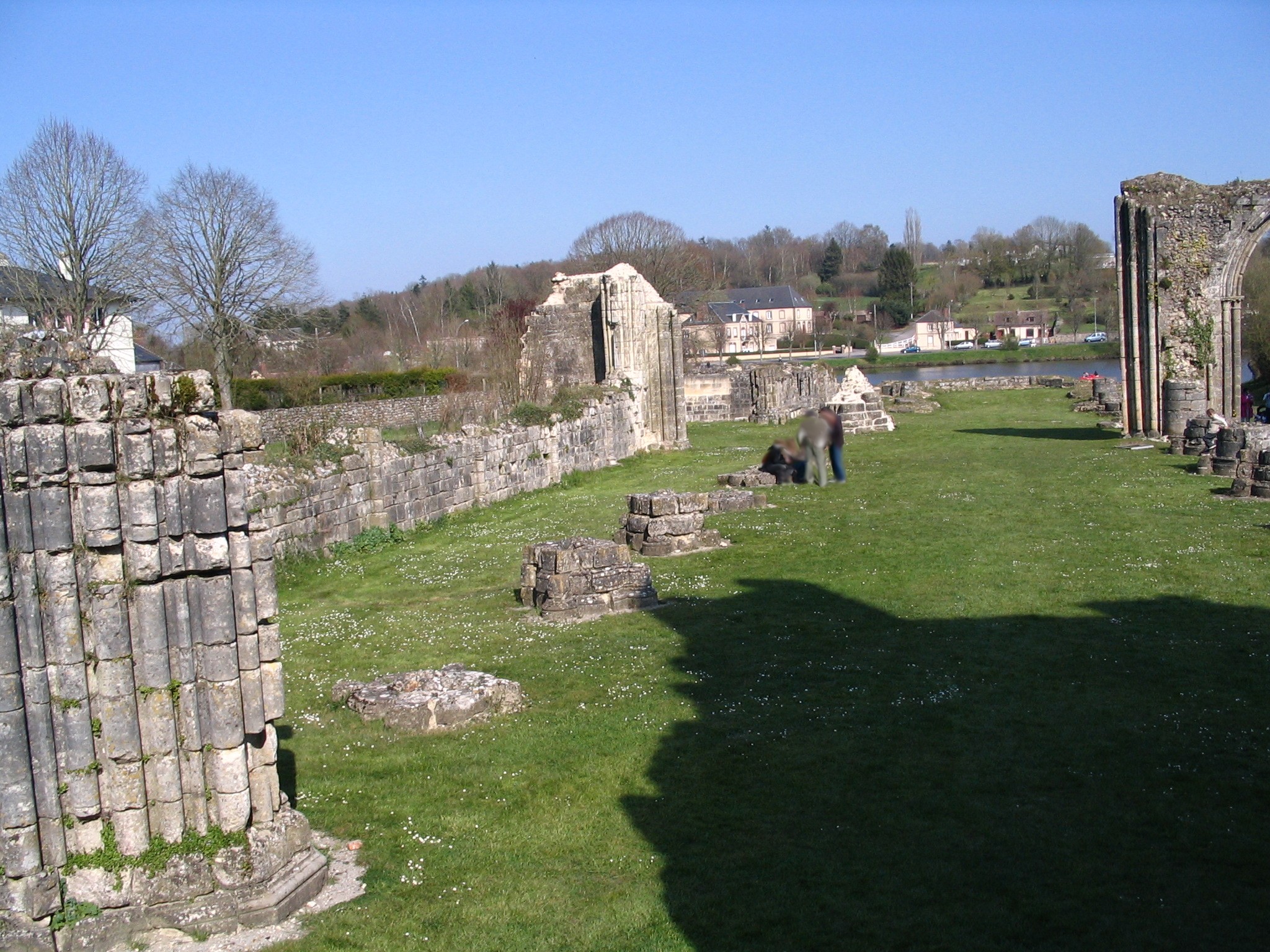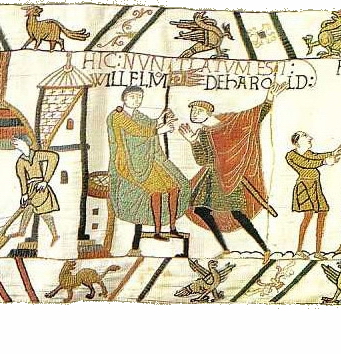|
William Fitz Giroie
William fitz Giroie (died 1057), Lord of Échauffour and Montreuil-l'Argillé. A Norman nobleman and patriarch of a large and powerful family in Normandy and Apulia. Career William was the second son of Giroie, Lord of Échauffour and Gisle, daughter of Thurston de Bastembourg lord of Montfort-sur-Risle. At their father's death in 1033, those properties making up his inheritance went to the eldest son Arnold, while most of the lands Giroie had acquired went to William.David Bates, ''Normandy before 1066'' (London; New York: Longman, 1982), p. 118 When Arnold died from an accidental fall in 1041, William was his heir and, less the smaller holdings that went to his two younger brothers, he inherited most of his father's lands. From that time on William was the family patriarch and according to Orderic Vitalis governed his family well. He headed a powerful family consisting of his brothers, sons, and numerous nephews all of whom were themselves formidable warriors.Ordericus Vitalis, ... [...More Info...] [...Related Items...] OR: [Wikipedia] [Google] [Baidu] |
William I Talvas
William I Talvas (c. 995 – c. 1060), seigneur of Alençon. According to Orderic Vitalis his nickname ''Talvas'' meaning shield, presumably alluded to his hardness or callousness like that of a shield. He was a member of the House of Bellême. Life He was a son of William of Bellême and Mathilde of Condé-sur-Noireau. He held lands at Bellême, Domfront and Alençon,Jean Jacques Gautier, ''Histoire d'Alençon'' (Poulet-Malassis, Imprimeur-Libraire, Place Bourbon, 1805), p. 24 He obtained the lands of Bellême from his brother Yves de Bellême, Bishop of SéezWhile Orderic stated that William Talvas succeeded his brother Robert, Yves (a.k.a. Ivo) inherited the lands of Bellême at the death of Robert about two years before he became Bishop of Séez in 1035. William Talvas probably held the lands from his brother Yves while he was Bishop and recovered the other family lands on his own. William Talvas never was lord of Bellême as evidenced by his use of his nickname 'Talvas' inst ... [...More Info...] [...Related Items...] OR: [Wikipedia] [Google] [Baidu] |
Year Of Birth Unknown
A year or annus is the orbital period of a planetary body, for example, the Earth, moving in its orbit around the Sun. Due to the Earth's axial tilt, the course of a year sees the passing of the seasons, marked by change in weather, the hours of daylight, and, consequently, vegetation and soil fertility. In temperate and subpolar regions around the planet, four seasons are generally recognized: spring, summer, autumn and winter. In tropical and subtropical regions, several geographical sectors do not present defined seasons; but in the seasonal tropics, the annual wet and dry seasons are recognized and tracked. A calendar year is an approximation of the number of days of the Earth's orbital period, as counted in a given calendar. The Gregorian calendar, or modern calendar, presents its calendar year to be either a common year of 365 days or a leap year of 366 days, as do the Julian calendars. For the Gregorian calendar, the average length of the calendar year ( ... [...More Info...] [...Related Items...] OR: [Wikipedia] [Google] [Baidu] |
William Of Montreuil
William of Montreuil (french: Guillaume de Montreuil) ( † aft. 1068), was an Italo-Norman freebooter of the mid-eleventh century who was briefly Duke of Gaeta. He was described by Amatus of Monte Cassino as "an exceptional knight, small in stature, who was very robust, strong, valiant" and by Orderic Vitalis as 'the good Norman' ( la, le bon Normand). Career He was a son of William fitz Giroie Lord of Échauffour and Montreuil-l'Argillé and Emma de Tannei, daughter of Walchelin de Tannei. By a charter to the Abbey of Saint-Evroul in 1050, William was still in Normandy at that time. Like his father and brother he granted all the monasteries he possessed, in return "for no small sum", to the abbey of Saint-Evroul.Ordericus Vitalis, ''The Ecclesiastical History of England and Normandy'', trans. Thomas Forester, Vol. I (London: Henry G. Bohn, 1853), p. 398 With his brother Arnold consenting, he granted the abbey his mills, farms and fisheries. Before leaving Normandy he also donate ... [...More Info...] [...Related Items...] OR: [Wikipedia] [Google] [Baidu] |
L'Aigle Family
The l'Aigle family was a Norman family that derived from the town of L'Aigle, on the southeastern borders of the Duchy of Normandy. They first appear during the rule of Duke Richard II of Normandy, in the early 11th century, and they would hold L'Aigle for the Norman Dukes and Kings of England until the first half of the 13th century, when with the fall of Normandy to the French crown the last of the line was forced to abandon the ancestral French lands, only to die in England a few years later without surviving English heirs. Their position on the borderlands, and near the headwaters of three rivers, the Risle, Iton and Avre, gave their small holding a special importance, as did a set of marriage connections that provided this relatively minor Norman noble family with a more elevated historical visibility.Kathleen Thompson, "The Lords of Laigle: Ambition and Insecurity on the borders of Normandy" in ''Anglo-Norman Studies''; XVIII; ed. Christopher Harper-Bill, Woodbridge, 1996, pp. ... [...More Info...] [...Related Items...] OR: [Wikipedia] [Google] [Baidu] |
Campania
Campania (, also , , , ) is an administrative Regions of Italy, region of Italy; most of it is in the south-western portion of the Italian peninsula (with the Tyrrhenian Sea to its west), but it also includes the small Phlegraean Islands and the island of Capri. The capital of the Campania region is Naples. As of 2018, the region had a population of around 5,820,000 people, making it Italy's third most populous region, and, with an area of , its most densely populated region. Based on its Gross domestic product, GDP, Campania is also the most economically productive region in southern Italy List of Italian regions by GDP, and the 7th most productive in the whole country. Naples' urban area, which is in Campania, is the List of urban areas in the European Union, eighth most populous in the European Union. The region is home to 10 of the 58 List of World Heritage Sites in Italy, UNESCO sites in Italy, including Pompeii and Herculaneum, the Royal Palace of Caserta, the Amalfi Coast and ... [...More Info...] [...Related Items...] OR: [Wikipedia] [Google] [Baidu] |
Pope Alexander II
Pope Alexander II (1010/1015 – 21 April 1073), born Anselm of Baggio, was the head of the Roman Catholic Church and ruler of the Papal States from 1061 to his death in 1073. Born in Milan, Anselm was deeply involved in the Pataria reform movement. Elected according to the terms of his predecessor's bull, ''In nomine Domini'', Anselm's was the first election by the cardinals without the participation of the people and minor clergy of Rome. He also authorized the Norman Conquest of England in 1066. Early life and work Anselm was born in the parish of Cesano Boscone in the town of Corsico some 7 km (5 mi) from Milan of a noble family. The family took its name from Baggio. a suburb of Milan, where the family held the office of "captain". According to the ''Liber pontificalis'', his father's name was Anselmus or Ardericus. Contemporary sources do not provide any information on where Anselm might have obtained his education. It was traditionally believed that An ... [...More Info...] [...Related Items...] OR: [Wikipedia] [Google] [Baidu] |
Bec Abbey
Bec Abbey, formally the Abbey of Our Lady of Bec (french: Abbaye Notre-Dame du Bec), is a Benedictine monastic foundation in the Eure ''département'', in the Bec valley midway between the cities of Rouen and Bernay. It is located in Le Bec Hellouin, Normandy, France, and was the most influential abbey of the 12th-century Anglo- Norman kingdom. Like all abbeys, Bec maintained annals of the house but uniquely its first abbots also received individual biographies, brought together by the monk of Bec, Milo Crispin. Because of the abbey's cross-Channel influence, these hagiographic lives sometimes disclose historical information of more than local importance. Name The name of the abbey derives from the bec, or stream, that runs nearby. The word derives from the Scandinavian root, ''bekkr''. First foundation The abbey was founded in 1034 by Saint Herluin, whose life was written by Gilbert Crispin, Abbot of Westminster, formerly of Bec, and collated with three other lives by Mi ... [...More Info...] [...Related Items...] OR: [Wikipedia] [Google] [Baidu] |
Sarthe
Sarthe () is a department of the French region of Pays de la Loire, and the province of Maine, situated in the ''Grand-Ouest'' of the country. It is named after the river Sarthe, which flows from east of Le Mans to just north of Angers. It had a population of 566,412 in 2019.Populations légales 2019: 72 Sarthe INSEE History In the late 18th century, before it was officially Sarthe, the nobility built their Mansions and Chateaux there, as an escape from Paris. The department was created during the on 4 March 1790, pursuant to the law of 22 December 1789, starting from a part of the |
Aunou-sur-Orne
Aunou-sur-Orne (, literally ''Aunou on Orne'') is a commune in the Orne department in northwestern France. History In 1811 Aunou-sur-Orne absorbed the neighbouring commune of Saint-Cenery-près-Séez (sometimes spelled Saint-Cénery-près-Sées or Saint-Céneri-près-Sées). Population Personalities Nicolas-Jacques Conté (4 August 1755 – 6 December 1805) was a French painter, balloonist, army officer, and inventor of the modern pencil. He was born at Saint-Céneri-près-Sées. See also *Communes of the Orne department The following is a list of the 385 communes of the Orne department of France. The communes cooperate in the following intercommunalities (as of 2020):Communes of Orne {{Orne-geo-stub ... [...More Info...] [...Related Items...] OR: [Wikipedia] [Google] [Baidu] |
Duke Of Normandy
In the Middle Ages, the duke of Normandy was the ruler of the Duchy of Normandy in north-western Kingdom of France, France. The duchy arose out of a grant of land to the Viking leader Rollo by the French king Charles the Simple, Charles III in 911. In 924 and again in 933, Normandy was expanded by royal grant. Rollo's male-line descendants continued to rule it until 1135. In 1202 the French king Philip Augustus, Philip II declared Normandy a forfeited fief and by 1204 his army had conquered it. It remained a French Province of France, royal province thereafter, still called the Duchy of Normandy, but only occasionally granted to a duke of the royal house as an apanage. Despite both the 13th century loss of mainland Normandy, and the extinction of the duchy itself in modern-day, republican France, in the Channel Islands the monarch of the United Kingdom is regardless still referred to by the title "Duke of Normandy". This is the title used whether the monarch is a king or a queen ... [...More Info...] [...Related Items...] OR: [Wikipedia] [Google] [Baidu] |
Robert De Grandmesnil
Robert de Grantmesnil (de Grandmesnil) also known as Robert II, was a Norman nobleman; a member of a prominent Norman family. He first became a monk, then abbot at the Abbey of Saint-Evroul in Normandy and later Bishop of Troina in the Norman Kingdom of Sicily. Career Robert was the second son of Robert I de Grantmesnil and Hawisa d'Échauffour, daughter of Giroie, Lord of Échauffour.K.S.B. Keats-Rohan, ''Domesday People, A Prosopography of Persons Occurring in English Documents 1066-1166'', Vol I (Woodbridge, UK: The Boydell Press, 1999), p. 262 His family was from Calvados, arrondissement of Lisieux, in the canton of Saint-Pierre-sur-Dives. As a child he applied himself to learning and came to be known for his retentive memory and seemed to be destined for the church.Ordericus Vitalis, ''The Ecclesiastical History of England and Normandy'', trans. Thomas Forester, Vol. I (London: Henry G. Bohn, 1853), pp. 400-401 But Robert also had a love of arms and fighting and was for fiv ... [...More Info...] [...Related Items...] OR: [Wikipedia] [Google] [Baidu] |






